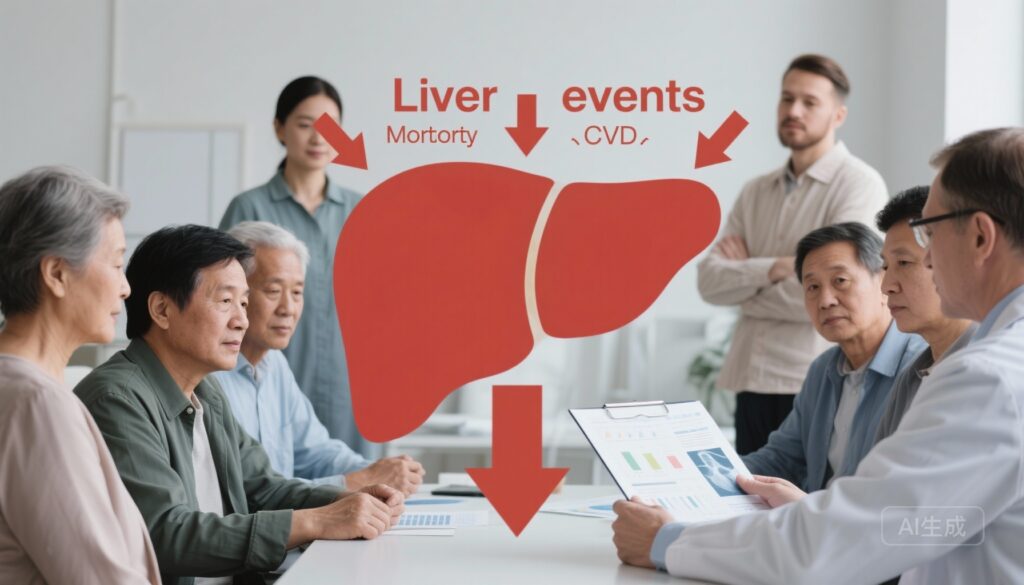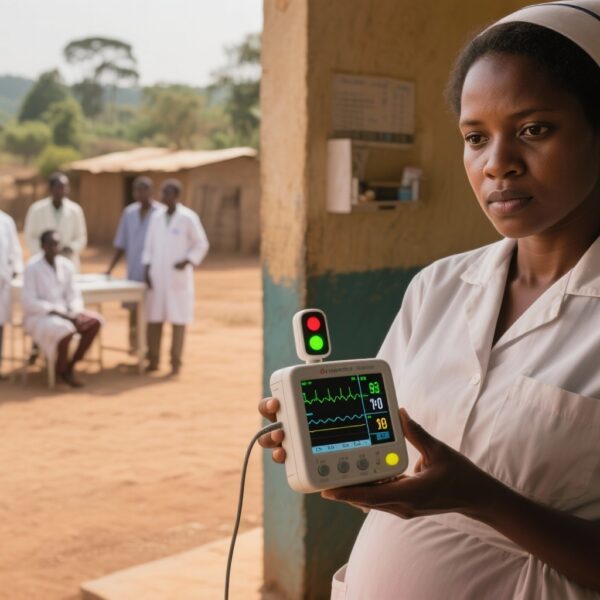Highlight
– A pooled analysis of 186,221 patients across UK Biobank, Kailuan and China Kadoorie Biobank found that lean MASLD (BMI<23 kg/m2 in Asian cohorts and <25 kg/m2 in UKB) is associated with higher liver-related events (HR 2.14) and higher all-cause (HR 1.26) and liver-related mortality (HR 2.31) compared with non-lean MASLD.
– Lean MASLD had comparable hepatocellular carcinoma and extrahepatic cancer risks but a modestly lower incident cardiovascular disease risk (HR 0.89) and lower CVD mortality than non-lean MASLD.
– Findings highlight the need to identify metabolic dysfunction and liver risk in patients with normal BMI and to not assume a benign prognosis on the basis of body weight alone.
Background
Metabolic dysfunction-associated steatotic liver disease (MASLD; previously widely referred to as nonalcoholic fatty liver disease, NAFLD) is the hepatic manifestation of systemic metabolic dysfunction and affects a large proportion of adults worldwide. MASLD encompasses a spectrum from simple steatosis to progressive steatohepatitis, fibrosis and hepatocellular carcinoma, and it is increasingly recognized as a cause of liver-related and extrahepatic morbidity and mortality. Global epidemiology studies indicate substantial prevalence and rising disease burden linked to obesity, diabetes and other cardiometabolic risk factors (Younossi et al., Hepatology 2016).
Until recently, clinical attention has focused on overweight and obese patients, but a substantial subgroup of individuals with MASLD have normal body mass index (BMI) — often termed “lean” MASLD. Whether lean MASLD carries a more favourable or worse prognosis than MASLD in persons with overweight/obesity has been controversial, with conflicting findings from small cohorts and variable definitions used across geographic regions. Clarifying prognosis in lean MASLD is important for screening policies, risk stratification and therapeutic decision-making worldwide.
Study design
The referenced multicohort prospective analysis pooled data from three population-based cohorts: UK Biobank (UKB), Kailuan cohort (China) and China Kadoorie Biobank (CKB). Together these cohorts encompassed 153,192 MASLD patients in UKB, 29,700 in Kailuan and 3,329 in CKB, totaling 181,191 non-lean and 5,030 lean MASLD patients after applying BMI thresholds (BMI <25 kg/m2 in UKB and <23 kg/m2 in the two Chinese cohorts) that reflect conventional Western and Asian definitions of normal weight.
Primary endpoints included liver-related events (LREs), hepatocellular carcinoma (HCC), liver-related mortality (LRM), cardiovascular disease (CVD) and CVD mortality, extrahepatic cancer, and all-cause mortality. Median follow-up was long (14.2 years overall), enabling assessment of hard clinical endpoints. Results were reported as hazard ratios (HRs) with 95% confidence intervals (CIs) and pooled across cohorts.
The study authors used contemporary MASLD nomenclature and adjusted analyses for key confounders; cohort-specific features, case-ascertainment methods and covariate definitions were harmonized where possible and then pooled for meta-analysis (Huo et al., Gut 2025).
Key findings
The study’s principal findings from pooled analyses are as follows (point estimates and 95% CIs reported by the authors):
- Liver-related events: lean MASLD was associated with a markedly higher risk of incident LREs (HR 2.14; 95% CI 1.27–3.62) compared with non-lean MASLD.
- All-cause mortality: lean MASLD had higher all-cause mortality (HR 1.26; 95% CI 1.14–1.39).
- Liver-related mortality: risk of death due to liver disease was higher in lean MASLD (HR 2.31; 95% CI 1.54–3.46).
- Cardiovascular disease: lean MASLD had a modestly lower risk of incident CVD (HR 0.89; 95% CI 0.83–0.95), and pooled CVD mortality was increased (HR 1.22; 95% CI 1.05–1.41) in lean MASLD compared with non-lean MASLD — although the direction of effect differed between incident events and mortality, suggesting complexity in competing risks and case-mix.
- Hepatocellular carcinoma: HR 1.76 (95% CI 0.84–3.71), with confidence interval crossing unity, indicating no statistically robust difference in HCC incidence between lean and non-lean MASLD in pooled analysis.
- Extrahepatic cancer: comparable risks between groups (HR 1.14; 95% CI 0.88–1.48).
Interpretation: Lean MASLD patients had worse liver-related outcomes and higher overall mortality despite having lower body weight. The lower incident CVD risk but increased CVD mortality signals heterogeneous cardiovascular phenotypes and potential differences in care or competing risks.
Cohort-level and subgroup considerations
The three-source design adds robustness by sampling both Western (UKB) and Asian (Kailuan, CKB) populations with different BMI distributions and metabolic risk profiles. The investigators used ethnicity-appropriate BMI cutoffs, which is critical because Asian populations manifest metabolic risk at lower BMI. Median follow-up of >13 years allowed detection of relatively uncommon outcomes such as LREs and HCC. The absolute event counts (e.g., 2,501 LREs, 22,482 deaths) provided sufficient statistical power for many endpoints, though some outcomes—like HCC—remained infrequent and confidence intervals wider accordingly.
Expert commentary and mechanistic plausibility
Why might lean MASLD portend worse liver outcomes and mortality? Several, not mutually exclusive, explanations are plausible:
- Visceral adiposity and ectopic fat: BMI is an imperfect proxy for adipose tissue distribution. Many lean individuals have increased visceral fat, decreased subcutaneous fat or increased hepatic triglyceride content despite normal BMI, which are stronger drivers of liver fibrosis progression.
- Sarcopenia and adverse body composition: low muscle mass coexisting with fat (sarcopenic obesity phenotype) is associated with worse outcomes and may be present in lean MASLD.
- Genetic predisposition: genetic variants (for example, PNPLA3) increase susceptibility to hepatic steatosis and fibrosis independent of BMI, and allele frequencies differ by ancestry.
- Under-recognition and under-treatment: clinicians may underappreciate metabolic risk in normal-BMI patients, leading to delayed diagnosis and less aggressive management of metabolic drivers (diabetes, dyslipidemia, hypertension).
- Competing risks and selection bias: lean patients who develop MASLD may have a different etiologic mix (e.g., higher proportion with metabolic dysfunction but lower classic CVD risk factors), producing the observed divergences in cardiovascular endpoints.
These mechanistic paths are supported by prior literature indicating that metabolic risk and visceral fat, rather than BMI per se, drive MASLD progression (Eslam et al., Lancet Gastro Hepatol 2020). The findings therefore underscore that normal BMI should not provide false reassurance.
Strengths and limitations
Strengths:
- Very large pooled sample across distinct populations and long follow-up, enhancing power to detect clinically important differences.
- Use of BMI thresholds aligned with regional guidelines improved cross-population comparability.
- Hard endpoints (mortality, incident LREs, HCC, CVD) minimize measurement error compared with surrogate markers.
Limitations:
- MASLD ascertainment and staging methods were cohort-specific; harmonization can leave residual misclassification. Most large cohorts lack detailed histology or systematic elastography on all participants, limiting granularity on baseline fibrosis stage, which is the main driver of prognosis.
- Residual confounding is possible — unmeasured factors such as dietary patterns, physical activity quality, socioeconomic variables and access to care differ across cohorts and between lean and non-lean groups.
- Healthy volunteer bias in UK Biobank and potential occupational or regional selection in Chinese cohorts may limit absolute generalizability.
- HCC events were relatively uncommon, so estimates are imprecise; subgroup analyses by fibrosis stage or genetic risk were not feasible at scale in pooled analysis.
Clinical implications
For clinicians and health systems, the message is actionable and immediate: normal BMI does not equate to low liver risk. Key implications include:
- Maintain a low threshold for assessing hepatic steatosis and fibrosis in patients with metabolic dysfunction irrespective of BMI. Tools such as transient elastography, fibrosis biomarkers (FIB-4, elastography where available), and careful metabolic evaluation should be considered.
- Screening and counselling should extend to lean individuals with diabetes, dyslipidemia, insulin resistance, hypertension or waist circumference indicative of central adiposity.
- Treatment strategies should focus on metabolic optimization (glycemic control, lipid management, blood pressure, lifestyle interventions) and referral for specialist assessment where fibrosis is suspected or confirmed.
- Clinical trials of MASLD therapies should ensure that lean patients are represented so that efficacy and safety across BMI strata are clarified.
Research priorities
Future studies should aim to:
- Characterize body composition (visceral fat, subcutaneous fat, muscle mass) and genetic risk in lean MASLD to elucidate mechanisms of progression.
- Assess the impact of earlier detection and targeted metabolic interventions on long-term hepatic and extrahepatic outcomes in lean MASLD via prospective interventional studies.
- Develop and validate risk stratification algorithms that incorporate metrics beyond BMI (waist circumference, imaging, biomarkers, genetics) to guide screening and surveillance.
Conclusion
This large pooled analysis across Western and Asian population cohorts demonstrates that lean MASLD is not a benign phenotype: lean patients exhibit higher liver-related events and greater all-cause and liver-related mortality than their non-lean counterparts, despite comparable risks for HCC and extrahepatic cancer and a lower incident CVD risk. Clinicians should not rely on BMI alone to estimate hepatic risk; rather, metabolic health, body composition and fibrosis assessment should guide care. Research to clarify mechanisms and to test targeted interventions in lean MASLD is a priority.
Funding and clinicaltrials.gov
The primary study referenced (Huo et al., Gut 2025) reports funding and cohort-specific support as detailed in the original publication. Readers should consult the original article for full funding disclosures and cohort registration details.
References
1. Huo Z, Chen Y, Huang Y, et al. Long-term prognosis of lean MASLD: evidence from three population-based prospective cohorts. Gut. 2025 Oct 15:gutjnl-2025-336127. doi:10.1136/gutjnl-2025-336127. PMID: 41093635.
2. Eslam M, Sanyal AJ, George J. MAFLD: A consensus-driven proposed nomenclature for metabolic associated fatty liver disease. Lancet Gastroenterol Hepatol. 2020;5(10):706–708. doi:10.1016/S2468-1253(20)30188-2.
3. Younossi ZM, Koenig AB, Abdelatif D, Fazel Y, Henry L, Wymer M. Global epidemiology of nonalcoholic fatty liver disease—Meta-analytic assessment of prevalence, incidence, and outcomes. Hepatology. 2016;64(1):73–84. doi:10.1002/hep.28431.
4. Romeo S, Kozlitina J, Xing C, et al. Genetic variation in PNPLA3 confers susceptibility to nonalcoholic fatty liver disease. Nat Genet. 2008;40(12):1461–1465. doi:10.1038/ng.257.
Thumbnail prompt (AI image generation)
A medically styled editorial thumbnail: a split-scene showing (left) a slim middle-aged Asian woman and (right) an overweight middle-aged Caucasian man, both in a clinic setting with a doctor pointing to a liver ultrasound image on a monitor; overlay icons show an upward red arrow labeled “Liver risk” above the woman and a green downward arrow labeled “CVD” above the man; neutral clinical color tones, realistic style, focus on faces and the liver image.



